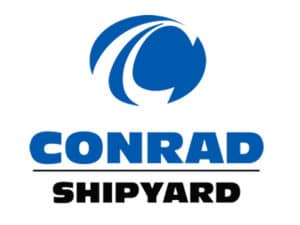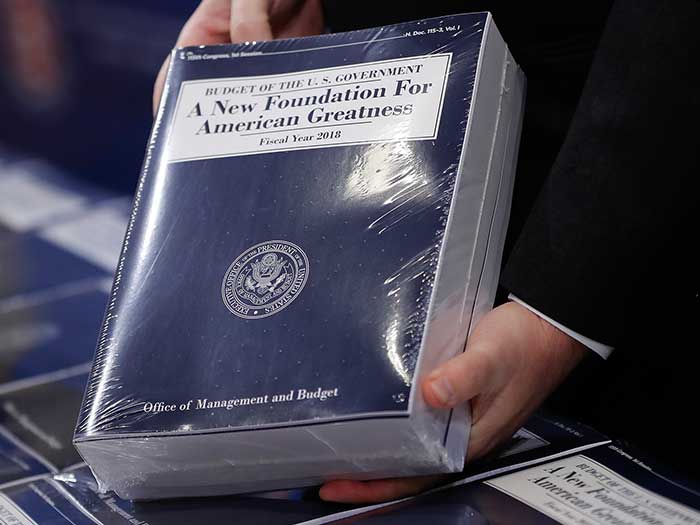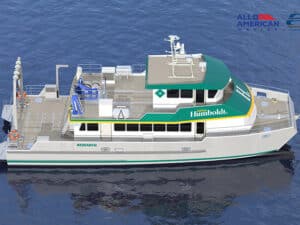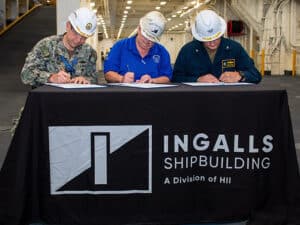
Only eight ships in FY2018 Navy shipbuilding budget
Written by Nick Blenkey
Fat book: Slim pickings for shipbuilders
MAY 24, 2017 — If you thought the Trump Administration would kickstart the path to a 355 ship Navy in its FY 2018 budget submission, think again. Though the overall Navy budget is up, this year’s shipbuilding request actually asks for fewer ships than were funded for FY 2017. Notably, just one LCS is requested. How all this fits with keeping those “hot production lines” at shipyards remains to be seen.
Ramping up to build a bigger fleet will come later. Earlier this month Chief of Naval Operations Adm. John Richardson released a future fleet overview that said that, though more ships are needed, the Navy “is already starting to implement a fleet design that portends significant changes in fleet architecture, and is seeking to deliver future capabilities more quickly to the waterfront. Put another way, a 355-ship Navy using current technology is insufficient for maintaining maritime superiority.”
He also said: “First, we need a year to consolidate our readiness and achieve better balance across the Navy. 2018 will be that year, and even as we restore wholeness, we’ll ensure that we continue to grow the Navy and establish a firm foundation for accelerating growth in following years.”
Ship procurement in the FY 2018 requests funds 8 new-construction ships: one CVN, two SSN, two DDG, one LCS/FFX, one T-ATS, and one T-AO 205, and 41 ships across the Future Years Defense Plan (FYDP).
Overall, the Navy’s baseline submission is an increase of $12.6 billion from the FY17 enacted budget. So, what’s going on?
For one thing, the Navy wants more sailors: $2 billion of the $12.6 billion is for military personnel. The budgeted end strength in FY 2018 is 327,900; approximately 4,000 higher than the estimated end strength for FY 2017.
According to a “Bottom Line” summary issued by the Deputy Assistant Secretary of the Navy (Budget). the Fiscal Year 2018 (FY18) baseline budget submission of $171.5 billion for the Department of the Navy (DON) is an increase of $12.6 billion (7%) from the FY17 enacted budget ($158.9 billion).
The summary notes that initial guidance from Secretary of Defense Mattis is clear: In FY17 fund readiness first, in FY18 restore program balance, and build capacity/improve lethality in FY19 and beyond.
The FY18 request for overseas contingency operations (OCO) of $8.5 billion continues to fund the incremental costs to sustain ongoing operational commitments, equipment/infrastructure repair, manpower, as well as equipment replacement.
The budget provides for a deployable battle force of 292 ships in FY18. This level of operational funding supports 11 aircraft carriers and 32 large amphibious ships that serve as the foundation upon which carrier and amphibious ready groups are based.
Thirteen battle force ships will be delivered in FY18: two Nuclear Attack Submarines (SSN), four Littoral Combat Ships (LCS), two Expeditionary Fast Transports (EPF), one Expeditionary Sea Base, oneAmphibious Transport Dock (LPD), two Destroyers (DDG) and one Zumwalt Class Destroyer (DDG 1000).
Two battle force ships will be retired: 1 Nuclear Attack Submarines (SSN) and the Afloat Forward Staging Base (Interim).
Key readiness programs are funded: ship depot maintenance 100% of projected maintenance; ship ops 58 days/quarter deployed & 24 days/quarter non-deployed; aircraft depot maintenance 89% of projected maintenance; flying hours deployed T-rating of 2.0; Marine Corps ground equipment to 79% of projected maintenance; and facilities sustainment to 78% (Navy) and 75% (Marine Corps) of sustainment model.
Research & Development is vital to provide for future technologies that support innovative capabilities in shipbuilding (Columbia class, Carrier replacement), aviation (JSF, Executive Helo), weapons (NextGen Jammer), lasers, and ground equipment. Technology enablers allow the DON to stay ahead of adversaries as their technological capabilities also advance.
Key investments in cyber resiliency include continued investment in core afloat (CANES) and ashore (NGEN) networks, increased network situational awareness as well as investments in aviation and shipboard systems resiliency.
If you have a team of analysts at your disposal, you can download all the Navy budget documentation HERE






Leave a Reply
You must be logged in to post a comment.